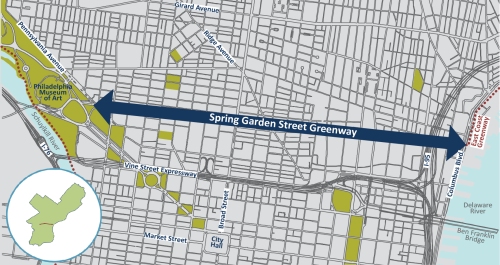Welcome to the Spring Garden Street Health Impact Assessment (HIA). Our goal is to identify and assess the potential effects of the proposed greenway on the health of the population that immediately surrounds Spring Garden in downtown Philadelphia. We define health holistically, taking into account both physical and mental health outcomes and recognizing that determinants of health outcomes can be environmental, economic, behavioral and political. The purpose of this HIA is not to endorse or oppose the proposed Greenway. Instead, this HIA aims to make health impacts a public part of the decision-making process.
Spring Garden runs through the heart of Philadelphia. It is 2.2 miles long and connects the Delaware River on the east and the Schuylkill River on the west. The Pennsylvania Economic Council is working with the East Coast Greenway Alliance and local partners to transform the street into a “linear park, a green street, and a high-quality walking and biking trail separate from traffic lanes” that will eventually connect to the East Coast Greenway, which is a 3,000 mile multi-use, off-road trail that will connect Maine to Florida and 25 urban areas along the way. The design plan includes a bi-directional center-median bikeway and an improved storm water runoff management system. Visit the Spring Garden Street Greenway website for more information.
After completing the screening, scoping and assessment phases of the HIA, our team concluded that the proposed Greenway will have an overall positive impact on health in the community immediately surrounding Spring Garden. We found both positive and negative potential health impacts, but we believe that the positive impacts vastly outweigh the negative ones. Most of our conclusions are based on literature and models created through empirical research in communities across the United States. As a next step, we strongly recommend conducting further research on the generalizability of these studies to the Philadelphia area.
The HIA was conducted during the spring of 2012 by a team of University of Pennsylvania graduate students and Fellows with backgrounds in planning, medicine and public health. The project was part of a class called “Community Development and Public Heath,” taught by Professor Amy Hillier. For more information on the team members, please visit the Contact page.






